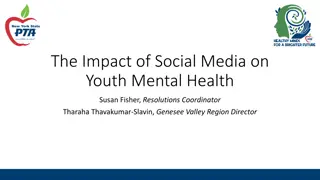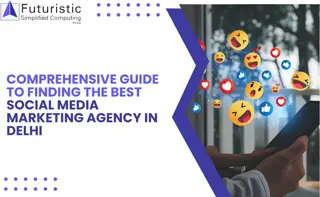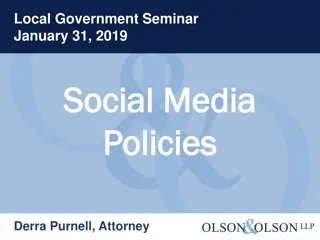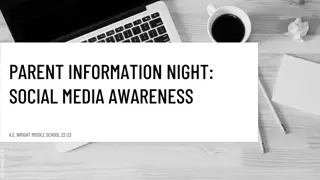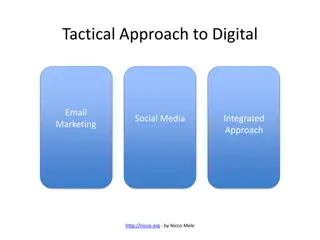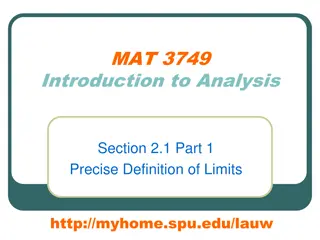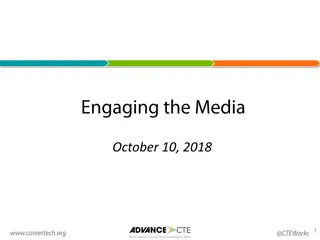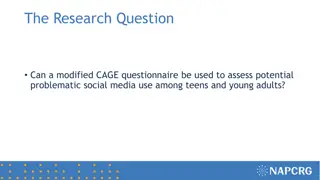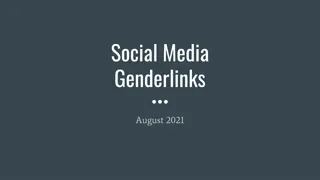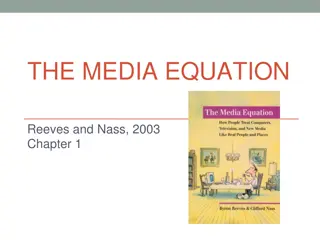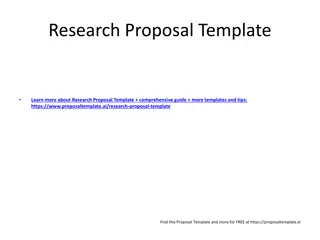Opportunities and Limits of Environmental Campaigns in China through Social Media
This study explores the impact of social media, particularly microblogging platforms like Sina Weibo, on environmental campaigns in China. It delves into the intersection of technology, activism, and governance, highlighting the opportunities and challenges faced by environmental activists in mobilizing public support and engaging with government agencies. The research investigates how ICTs have revolutionized online activism and facilitated collective action in the realm of environmental protection.
Download Presentation

Please find below an Image/Link to download the presentation.
The content on the website is provided AS IS for your information and personal use only. It may not be sold, licensed, or shared on other websites without obtaining consent from the author.If you encounter any issues during the download, it is possible that the publisher has removed the file from their server.
You are allowed to download the files provided on this website for personal or commercial use, subject to the condition that they are used lawfully. All files are the property of their respective owners.
The content on the website is provided AS IS for your information and personal use only. It may not be sold, licensed, or shared on other websites without obtaining consent from the author.
E N D
Presentation Transcript
Environmental Campaigns in China through Social Media : Opportunities and Limits Yixian Sun Department of International Relations/Political Science Graduate Institute of International and Development Studies Workshop ICTs And Governance In Europe and China November 25, 2016, Confucius Institute, Geneva
Overview 2 1. PM 2.5 campaing in 2011-2012 Fedorenko, I., & Sun, Y. (2016). Microblogging-Based Civic Participation on Environment in China: A Case Study of the PM 2.5 Campaign. VOLUNTAS: International Journal of Voluntary and Nonprofit Organizations. Vol. 27, Issue 5, pp 2077 2105. 2. Recent campaigns on sustainable consumption Nov. 25, 2016 Yixian Sun
Background Two parallel trends in contemporary China 3 Number of abrupt environmental incidents in China (source: PRC's Ministry of Enviornmental Protection) 800 700 600 500 400 300 200 100 0 2005 2006 2007 2008 2009 2010 2011 2012 2013 2014 Internet Users in China source: China Internet Network Information Center) 800 60.00% 50.00% 600 40.00% 400 30.00% 20.00% 200 10.00% 0 0.00% 2005 2006 2007 2008 2009 2010 2011 2012 2013 2014 2015 Number (unit: million) Percentage Nov. 25, 2016 Yixian Sun
Research Question 4 ICTs change the width and speed of information transmission online activism Internet-based collective action that promotes, contests or resists change (Yang 2009) Increased use of mobile phones and the Internet has allowed protesters to show their anger more effectively. --- a member of the national committee of the CCPCC How the public have been mobilized in social media (microblogging)-based environmental campaigns? Actors and their networks Social norms Nov. 25, 2016 Yixian Sun
Analytical Framework I 5 ICTs provide new opportunities for Chinese environmental activists green public sphere Horizontal and Vertical interactions in the online space (Yang and Calhoun 2008, Yang 2009, Xie 2009) Features of Sina Weibo (a twitter-like platform): Dominance of a single one platform - More than 300 million in 2012 Users include many public figures and government agencies Anonymous posting Propositions: Promoting intensive horizontal interaction among environmental activists, and between activists and citizens, involving a wider public Enabling vertical interaction between the government on the one hand, and environmental activists and the public on the other. Nov 25, 2016 Yixian Sun
Analytical Framework II 6 Framing strategy to mobilize the public in China s authoritarian setting Public mobilization needs a frame having a wider resonation within society, employing personal concerns, and being not critical towards the government. (Mertha 2010) Environmentalism vs. NIMBYism (Johnson 2010) Proposition: The link between air pollution and public health is crucial to explain the success of the air pollution campaign Nov. 25, 2016 Yixian Sun
Research Design 7 A single case study: a large-scale campaign against air pollution across the country from October 2011 to early 2012, based on Sina Weibo, the then most influential social media in China; considered as the biggest victory of civil society in the history of environmental campaigning in China. Methodology: process tracing, discourse analysis, semi-structured interviews (18), and participant observations. Nov. 25, 2016 Yixian Sun
Campaign process 8 Thick smog was appeared in many Chinese cities, but official data showed the air quality as qualified or only mild polluted . Sept- Oct 2011 Many people started to discuss online about air pollution, Weibo soon became a public sphere for relevant discussions. Discrepancies between the Chinese government s Air Pollution Index and an Air Quality Index published by the US Embassy in Beijing triggered intense online debates Oct. The term PM 2.5 became highly popular on the online public - thousands of microblogs were calling for strengthened air quality standards in China to monitor PM2.5. A mass online protest has occurred across the country on Weibo Late Oct. MEP elaborated a draft of the new National Ambient Air Quality Standards which include the monitoring of PM2.5, but only requires compulsory implementation in 2016 Nov 16 Many provincial and municipal governments expressed their willingness of implementing immediately the new standards, but campaign participants were unsatisfied with the MEP s decision and openly called it into question on Weibo. Dec. The then Chinese environment minister announced that big cities and cities in the developed areas will be required to implement the new standards in 2012, this decision was officially confirmed by the State Council on February 29, 2012. Dec. 26
Critical Juncture The online poll in 6 -13 Nov 2011, initiated by Pan Shiyi 9 Experts said PM2.5 in the air is extremely dangerous to the human. Only if the compulsory standards can be imposed by the state, every city can implement them. Once people understand the seriousness of the problem, everyone can spontaneously prevent air pollution, change their unhealthy habits and lifestyles. Please vote and share this weibo. In one week, I will write a letter with the result of this vote to the environment minister. - This year - Next year - Never Source: http://vote.weibo.com/vid=1127783 Nov. 25, 2016 Yixian Sun
Key actors and relevant social networks 10 A milestone of civic participation in China: the public has directly influenced a policy at the national level. Leading role of environmental activists 1. Environmental activists expressed their concern on PM2.5 on Weibo before the problem moved under spotlight. 2. Key figures are far more active than lay people in the campaign produce new information and set new agenda. The Weibo platform helped environmental activists to create a matter of concern (i.e. PM 2.5) as a basis of the large-scale online protest that has involved a wider public including public figures and ordinary internet users. Nov 25, 2016 Yixian Sun
Actor networks in the PM 2.5 campaign 11 Ordinary Internet users Celebrities and citizens willing to tackle air pollution Network of green discourse and knowledge established by environmental activists Nov. 25, 2016 Yixian Sun
Vertical Interaction 12 Lively exchange on Weibo between some governmental officials and the public/environmental activists The then deputy Director of Beijing Bureau of Environmental Protection Weibo accounts of many local governmental agencies became the targets of public protests, and their proactive response to questions and critiques from the public further encourage public participation In early November, the Meteorological Bureau of Nanjing said the city was prepared for monitoring PM2.5 and disclosing related data. Nov. 25, 2016 Yixian Sun
Framing in the PM2.5 campaign 13 Diagnostic framing identify injustice and attributing blame to something Prognostic framing articulate possible solutions Motivational framing give people a reason to act 26 articles with referencing to PM 2.5 have been analyzed from major Chinese and foreign newspapers and the Chinadialogue website. Overall pattern: NIMYBism + Not blame the government Nov. 25, 2016 Yixian Sun
Findings 14 Social media platforms greatly expand the networks of Chinese environmental activists by involving influential public figures and governmental agencies. The NIBYism frames liking air pollution to health, and the frames appreciating governmental efforts are critical to the success of civic participation in today s Chinese environmental governance. Nov. 25, 2016 Yixian Sun
Recent Developments Use of social media in campaigns for sustainable consumption 15 Goal: raise consumers awareness change behaviors New trends: Leverage resources of various actors: ENGOs (e.g. WWF), retailers (e.g. CCFA), intergovernmental organizations (UNEP), standard-setting organizations (e.g. MSC), product brands Information sharing and online interaction through Wechat Wechat has become the leading social media platform, 78.7% vs 34% for Weibo (CINIC 2016) Nov. 25, 2016 Yixian Sun
Challenge 1: intimite circles 16 Are Wechat-based campaigns able to reach more people? Wechat a stronger sense of community, but smaller networks ( homophily effects ) Need innovative solutions to make connections between different networks Nov. 25, 2016 Yixian Sun
Challenge 2: price premium and framing 17 Can such campaigns change people s consumption behaviors? Because of price premium, consumers may be unwilling to change pay more to buy sustainable products even if they understand social values embedded in these products Potential solution: emphasis on other salient issues than sustainable development, such as food safety Nov. 25, 2016 Yixian Sun
Future Research 18 More empirical research on effectiveness of such campaigns Consumer surveys to examine whether social media is a key channel of awareness raising Experiments to which framing is the most effective one to change consumers behaviors Nov. 25, 2016 Yixian Sun
19 Thank you! yixian.sun@graduateinstitute.ch





